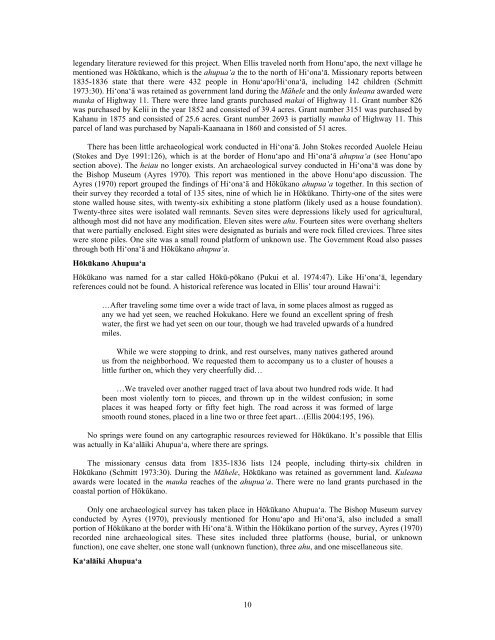Honu'apo Park Resource Management Plan
Honu'apo Park Resource Management Plan
Honu'apo Park Resource Management Plan
You also want an ePaper? Increase the reach of your titles
YUMPU automatically turns print PDFs into web optimized ePapers that Google loves.
legendary literature reviewed for this project. When Ellis traveled north from Honu‘apo, the next village he<br />
mentioned was Hōkūkano, which is the ahupua‘a the to the north of Hi‘ona‘ā. Missionary reports between<br />
1835-1836 state that there were 432 people in Honu‘apo/Hi‘ona‘ā, including 142 children (Schmitt<br />
1973:30). Hi‘ona‘ā was retained as government land during the Māhele and the only kuleana awarded were<br />
mauka of Highway 11. There were three land grants purchased makai of Highway 11. Grant number 826<br />
was purchased by Kelii in the year 1852 and consisted of 39.4 acres. Grant number 3151 was purchased by<br />
Kahanu in 1875 and consisted of 25.6 acres. Grant number 2693 is partially mauka of Highway 11. This<br />
parcel of land was purchased by Napali-Kaanaana in 1860 and consisted of 51 acres.<br />
There has been little archaeological work conducted in Hi‘ona‘ā. John Stokes recorded Auolele Heiau<br />
(Stokes and Dye 1991:126), which is at the border of Honu‘apo and Hi‘ona‘ā ahupua‘a (see Honu‘apo<br />
section above). The heiau no longer exists. An archaeological survey conducted in Hi‘ona‘ā was done by<br />
the Bishop Museum (Ayres 1970). This report was mentioned in the above Honu‘apo discussion. The<br />
Ayres (1970) report grouped the findings of Hi‘ona‘ā and Hōkūkano ahupua‘a together. In this section of<br />
their survey they recorded a total of 135 sites, nine of which lie in Hōkūkano. Thirty-one of the sites were<br />
stone walled house sites, with twenty-six exhibiting a stone platform (likely used as a house foundation).<br />
Twenty-three sites were isolated wall remnants. Seven sites were depressions likely used for agricultural,<br />
although most did not have any modification. Eleven sites were ahu. Fourteen sites were overhang shelters<br />
that were partially enclosed. Eight sites were designated as burials and were rock filled crevices. Three sites<br />
were stone piles. One site was a small round platform of unknown use. The Government Road also passes<br />
through both Hi‘ona‘ā and Hōkūkano ahupua‘a.<br />
Hōkūkano Ahupua‘a<br />
Hōkūkano was named for a star called Hōkū-pōkano (Pukui et al. 1974:47). Like Hi‘ona‘ā, legendary<br />
references could not be found. A historical reference was located in Ellis’ tour around Hawai‘i:<br />
…After traveling some time over a wide tract of lava, in some places almost as rugged as<br />
any we had yet seen, we reached Hokukano. Here we found an excellent spring of fresh<br />
water, the first we had yet seen on our tour, though we had traveled upwards of a hundred<br />
miles.<br />
While we were stopping to drink, and rest ourselves, many natives gathered around<br />
us from the neighborhood. We requested them to accompany us to a cluster of houses a<br />
little further on, which they very cheerfully did…<br />
…We traveled over another rugged tract of lava about two hundred rods wide. It had<br />
been most violently torn to pieces, and thrown up in the wildest confusion; in some<br />
places it was heaped forty or fifty feet high. The road across it was formed of large<br />
smooth round stones, placed in a line two or three feet apart…(Ellis 2004:195, 196).<br />
No springs were found on any cartographic resources reviewed for Hōkūkano. It’s possible that Ellis<br />
was actually in Ka‘alāiki Ahupua‘a, where there are springs.<br />
The missionary census data from 1835-1836 lists 124 people, including thirty-six children in<br />
Hōkūkano (Schmitt 1973:30). During the Māhele, Hōkūkano was retained as government land. Kuleana<br />
awards were located in the mauka reaches of the ahupua‘a. There were no land grants purchased in the<br />
coastal portion of Hōkūkano.<br />
Only one archaeological survey has taken place in Hōkūkano Ahupua‘a. The Bishop Museum survey<br />
conducted by Ayres (1970), previously mentioned for Honu‘apo and Hi‘ona‘ā, also included a small<br />
portion of Hōkūkano at the border with Hi‘ona‘ā. Within the Hōkūkano portion of the survey, Ayres (1970)<br />
recorded nine archaeological sites. These sites included three platforms (house, burial, or unknown<br />
function), one cave shelter, one stone wall (unknown function), three ahu, and one miscellaneous site.<br />
Ka‘alāiki Ahupua‘a<br />
10


